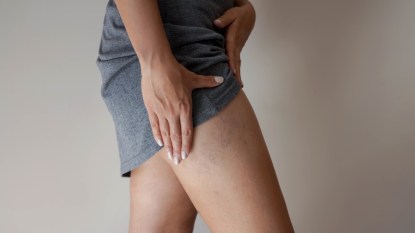Doctors Weigh In on The Best Natural Solutions for Female Bladder Problems
Leak when you laugh? These simple tricks help you dodge incontinence, UTIs, urinary urgency and more

Ever leak a little when you laugh? Prone to painful bladder infections? Or maybe you find yourself trekking to the bathroom overnight when you should be sleeping. When female bladder problems flare up, they can do more than just cause embarrassment and discomfort. They can keep you from enjoying your favorite activities, too. Fortunately, help is here! These natural remedies help stop trouble before it ever even starts.
Why women are prone to bladder problems
“Many women deal with bladder issues as they age because of hormonal and body chemistry changes,” says urogynecologist Elizabeth Kavaler, MD, medical director of Total Urology Care of New York and author of A Seat on the Aisle, Please!: The Essential Guide to Urinary Tract Problems in Women. “As we age, everything sags. Our tissues get less elastic, we have less muscle mass, and things happen where our body just gets worn out. Your urinary tract deteriorates, too.”
And then there’s the hormone swings. During menopause, your estrogen levels begin to drop, and this can affect your anatomy. “A lack of estrogen causes the overall thinning and weakening of tissues, with less blood supply and lubrication,” explains Linda Burkett, MD, a urogynecologist at VCU Health in Richmond, VA and an assistant professor in the OB/GYN department at the Virginia Commonwealth University School of Medicine. “The pH in the vagina changes and the good bacteria cannot grow, leading to them being outnumbered by bad bacteria that cause infections.”
Bladder problems can also be passed on through genes. “They are much more common to run in families,” says Dr. Kavaler. “If your mother or your aunt had a urinary tract issue, it’s more likely you will too.” Some bladder problems predominantly affect women over 50. Read on to learn more about the most common female bladder problems — and how to outsmart them naturally.
Urinary tract infections (UTIs)
A urinary tract infection happens when bad bacteria enter your urethra, bladder, or kidneys, (all parts that make up the urinary tract). The most common type of UTI is a bladder infection, or cystitis. UTIs are so common that they contribute to more than 8.1 million visits to health care providers every year, according to the Urology Care Foundation.
Nearly half of all women experience at least one urinary tract infection in their lifetime, and women get UTIs up to 30 times more often than men. Why? A woman’s urethra is shorter, which makes it easier for bacteria to find its way to the bladder. What’s more, those who have had UTIs in the past or who are going through menopause are more at risk for infections. With the loss of estrogen, vaginal tissue can become thin and dry, making it easier for harmful bacteria to grow.
People with diabetes are at an increased risk, too. They have more compromised immune systems, making them more vulnerable to infections such as a UTI. In fact, a study in Nature Communications showed diabetics have lower levels of an antimicrobial compound called peptide psoriasin, which weakens the bladder’s protective cell barrier and increases UTI risk.

Related: Doctors Say if You See This in Your Urine, It Could Be an Early Warning Sign of a UTI
The most common symptoms of a UTI
Symptoms of a UTI include a frequent and urgent need to urinate, pain or burning during urination, cloudy, or strange smelling urine. An infection can cause cause fatigue, pain or pressure in the back or lower abdomen, or passing only small amounts of urine. While over-the-counter testing kits can help clue you in if something’s amiss, Dr. Burkett says you’re better off visiting your doctor to confirm an infection. She cautions that “with a drugstore kit, you can get a false positive or a false negative.”
How to prevent a UTI
Drink more H2O
Women with recurrent UTIs who drank an additional 1.5 liters (about 6 cups) of water a day were 50% less likely to get another UTI than those who didn’t increase their water intake, a study in JAMA found. Study authors theorize drinking more water and urinating more frequently flushes out bacteria. (Click through to see how a motivational water bottle can increase your daily water intake.)
Supplement with cranberries
Research in the journal Cochrane Database of Systematic Reviews found cranberries reduced the risk of symptomatic recurrent UTIs by 69%. Credit goes to proanthocyanidins (PACs), compounds in cranberries that block bacteria from sticking to the walls of the bladder. Dr. Burkett suggests a daily cranberry supplement that has 36 mg. of PACs. One to try: Triquetra CranEaze Cranberry Extract tablets (Buy from Amazon, $21.99). If you prefer to sip cranberry juice instead, stick to an unsweetened variety. The National Association for Continence says sugar increases the amount of acid in your urine, which creates a better environment for the bacteria to grow.

Visit the bathroom more frequently
“Holding it” when you have to urinate not only can be uncomfortable, but it can lead to a UTI. Since bacteria thrive in warm and wet places, emptying your bladder when you feel the urge gives the troublemakers nowhere to reside and multiply. A study in BMC Infectious Diseases found women who frequently holding in urine were more likely to develop a UTI.
Related: Goodbye, Bladder Leaks! Doctors Reveal the Best Urinary Incontinence Remedies
Urinary incontinence
If you’ve ever let out a chuckle only to realize you’ve leaked urine, then you likely have urinary incontinence. Urinary incontinence affects twice as many women as men, according to the Office on Women’s Health. The two most common types are stress incontinence and urge incontinence, otherwise known as overactive bladder.
Stress incontinence occurs when your bladder leaks upon physical exertion, such as lifting something heavy, exercising, coughing, sneezing, or laughing. It happens when the tissues and pelvic floor muscles supporting your bladder and urethra weaken. “One of the biggest risk factors for stress incontinence is age,” says Dr. Burkett. “Over time you lose strength in your pelvic floor muscles, and there’s less connective tissue so there’s an overall lack of anatomical support around the bladder and the urethra.”

Urge incontinence affects more than 40% of women in the U.S., according to the Urology Care Foundation. It happens when the muscle in the bladder that pushes urine out goes into overdrive, resulting in frequent urination. “When you have to urinate more than eight times a day, you have an overactive bladder,” says Dr. Kavaler.
One reason this happens has to do with your muscular and nervous systems, which work in tandem to hold and release urine at the right time. Nerves carry messages between the brain, spinal cord and bladder indicating when the muscles of the bladder should tighten or release. Sometimes, these nerve signals go awry, telling you to urinate at the wrong time. Past pelvic or back surgery, herniated discs, or having a UTI all increase your risk of urinary incontinence. (Click through to learn how bladder spasms can trigger leaks — and how to fix them.)
How to prevent urinary incontinence
Do Kegel exercises
It’s true that limiting your intake of caffeine and alcohol, which can irritate the bladder and cause spasms, helps. But many women’s health experts recommend Kegel exercises as their go-to for urinary incontinence. These simple moves strengthen your pelvic floor, helping your body only release urine when you’re ready. Here’s what the American College of Obstetricians and Gynecologists recommends:
- Squeeze the muscles you’d use if you want to stop the flow of urine
- Hold for 3 seconds, then relax for 3 seconds
- Repeat this contract-and-relax sequence 10 times, three times daily
- Each week, increase your hold by 1 second, working your way up to 10-second holds
Soak up the sun
A study in Nutrition Reviews found when women with overactive bladder shored up their stores of vitamin D, they reduced their risk of urinary incontinence by 66%. The best way to get vitamin D is through sunlight, since your body naturally produces it when bare skin is exposed to the sun. Aim to get 5 to 15 minutes of sunlight daily. Or supplement with 600 to 800 IU of vitamin D3 daily. (Click through to our sister publication to discover more of the health benefits of vitamin D3.)

Focus on the present
When women with urinary incontinence practiced mindfulness meditation for 8 weeks, they decreased their number of overactive bladder episodes up to 70%, according to a University of Utah study. Study authors say this easy type of meditation, in which you focus your attention on the present and let go of your worries, tamps down stress that can trigger bladder spasms. Click through for a 5-minute mindfulness meditation practice to get you started.
For extra help, consider Botox
If other treatments and lifestyle modifications don’t work, your doctor may suggest Botox. When Botox is injected into the bladder muscle, it relaxes it along with the nerve stimulators that affect the nerves, says Dr. Kavaler. “The bladder is controlled by the nervous system, so we try to manage overactive bladder through both the neurological and muscular systems.”
The procedure only takes about a minute and a half and is done in the doctor’s office. Research has shown it can last up to 6 months. One study in Porto Biomedical Journal reports a Botox injection for overactive bladder provided relief for 66% of folks. (Botox can also help with TMJ: Click through to see how masseter Botox can ease jaw pain.)
Nocturia, or overnight urination
If you wake up more than once a night to go to the bathroom, that’s considered nocturia. Research in Reviews in Urology show up to 76% of women deal with nocturia. Everything from menopausal hormone changes to decreased bladder capacity cause this pesky condition to flare up more with age. And when you’re constantly getting up to go to the bathroom overnight, you’re likely not getting the deep rest your body craves. The result: You wake up feeling foggy and groggy.
How to prevent nocturia
Try melatonin, nature’s sleep aid
Melatonin may be famous for helping you catch more Zzzs, but it can also ward off overnight treks to the bathroom. Research published in The Journal of Urology found taking melatonin before sleep decreases urine volume like an antidiuretic and increases bladder capacity by up to 64%. This helps you snooze soundly without being awoken overnight with “gotta go” urges. To get the benefits, take 1 to 3 mg. melatonin about 30 to 60 minutes before bed. (What else can help deepen your sleep? A type of sound therapy known as binaural beats.)
Do this on your before-bed bathroom run
Even if you feel like you’ve entered your bladder completely before bed, make a final trip to the bathroom and try this: Lean forward for 20 seconds after urinating, (as if you’re taking a seated bow), then sit up for 10 seconds and try to urinate again. Research from Brigham and Women’s Hospital suggests compressing your bladder twice eliminates liquid that’s building up before your body even detects it, allowing you to snooze soundly. (Tip: Compression socks can help prevent fluid build-up, too. Click through to our sister publication to find out if you can sleep in compression socks to ease nocturia.)
Read on for more ways to outsmart female bladder problems:













